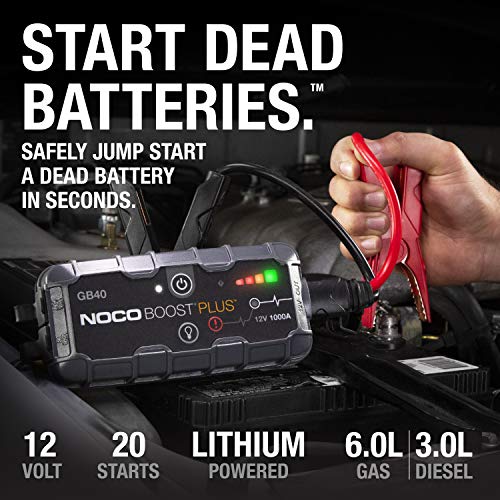If you’ve got a small boat or a tight budget, you may not want to purchase multiple batteries for your outboard motor, your trolling motor, and any other electronics you may have.
Is it possible to get away with only one battery on board?
Can you use a jump starter to power your trolling motor instead of a battery?
Great questions!
Let’s dive right in and explore the answers, shall we?
Table of Contents
Will a Jump Starter Power a Trolling Motor?
A jump starter is basically a large battery with jumper cables attached. You may have one in your car so you can give yourself a jump start if your battery ever dies and no one’s around to help.

For that matter, you may even keep one on board your boat in case you ever experience battery trouble while out on the water.
What if you could put that jump starter to use in your everyday boating adventures? Will it power a trolling motor?
The short answer is yes, but there are a multitude of factors you’ll want to consider before using a jump starter in place of a battery.
Let’s take a look at some of those factors.
Jump Starter Pros

- Jump starters are lightweight and portable. With small inflatables and kayaks, space for a battery may be limited. You may also be concerned about overloading your boat with gear and passengers.
Jump starters work great in these circumstances because they are usually small, lightweight, and easily portable. You can stick them anywhere you have a bit of extra space on board.
- Jump starters are inexpensive. Compared to regular marine or deep cycle batteries, most jump starters are relatively cheap. This means you have a small investment up front and can easily justify replacing them more often than batteries.
- Jump starters are versatile. Not only can you use a jump starter to power your trolling motor, but you can use it for other portable power needs, such as camping applications. They are self-charging, which makes them convenient for outdoor uses.
Jump starters provide a cheap, easy and versatile way to enjoy a number of recreational activities, but they do have their limitations.
Jump Starter Cons
- Jump starters won’t last long between charges. Naturally, jump starters are made for starting engines. They are designed to deliver quick, short bursts of electrical power, not long, sustained currents.
While exceptions are always possible, you should not expect to get more than an hour or two of battery life out of your jump starter when using it to power your trolling motor. Some may last for even shorter time periods.
- Jump starters don’t provide enough power for larger boats. Again, short bursts of power are what jump starters do best. Larger motors running at higher settings will cause them to discharge quickly, cutting your time on the water short.
It’s also worth noting that some jump starters don’t even provide enough amperage for larger trolling motors, so you’ll want to check your manual and make sure your motor won’t try to draw more than the jump starter can safely produce.
- Jump starters need to be replaced more often than deep cycle batteries. Because they aren’t really designed for frequent discharges, a jump starter that is used to power a trolling motor will wear out more quickly than a deep cycle battery.
Of course, as mentioned, jump starters are also much cheaper than deep cycle batteries, so if the pros outweigh the cons for your particular boating needs, you may be more willing to replace your jump starter as often as necessary.
How to Use a Jump Starter with Your Trolling Motor
Powering your trolling motor with a jump starter is actually quite easy and simple. Here are the steps.
- First, you’ll need to identify the battery cables in your trolling motor. They are usually easy to recognize as red and black cords running from the motor’s control head, but if you’re not sure, check your owner’s manual for proper identification.
- Clamp the red cable from the jump starter onto the red trolling motor cord’s battery terminal. Repeat with the black cable clamp and the black trolling motor cord. It should look something like what is shown in this video.
- If the clamps don’t attach securely to the battery terminals, or if you’re worried about a loose connection, then you can cut off the jump starter clamps and crimp them to the trolling motor’s cord, as though you were simply extending your battery cables.
- Even if you don’t remove the clamps from the jump starter, you may want to secure the trolling motor’s cables to the clamps by wrapping the connection with electrical tape.
- Mount the jump starter in your boat as you would a regular battery. It might not be a bad idea to purchase a simple battery box to protect the jump starter from the elements, but this isn’t as necessary as it would be with a regular deep cycle battery.
- If you haven’t already, now would be a good time to wire a fuse to your trolling motor. Some trolling motors come with fuses, but if you don’t have any you can easily find them at your local marine supply shop.
- That’s all there is to it!
Remember, this isn’t an ideal set up for medium or large boats, and in general, jump starter manufacturers won’t recommend using a jump starter in place of a battery to power your trolling motor.
But, for recreational uses and lightweight boats, this can be a great way to enjoy a bit of fun on the water without having the cost or added weight of a regular battery.
Conclusion
Jump starters can power trolling motors for up to a couple of hours and may work well for small, lightweight boats. If you keep a jump starter on board and you’ve been wondering about using it in place of your trolling motor battery, then why not give it a try?

Sarah Hood has been writing for Anchor Travel since 2021. When she’s not writing, she enjoys cooking, singing, and spending time in the great outdoors.


